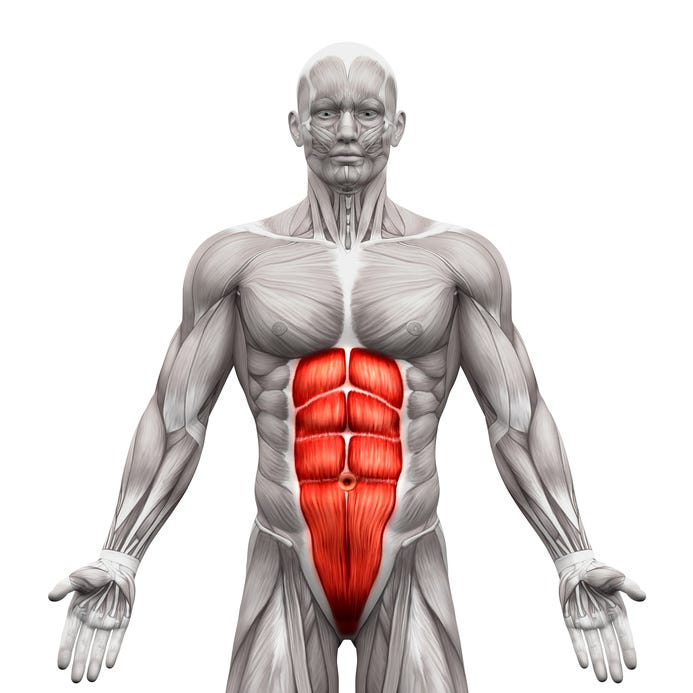Everything you need to know about training your core
Bigger abs, less lower back pain, and stronger lifts
Ahhh core training.
Hated by some.
Loved by others.
Needed for everyone.
The first and most important thing to understand about training your core, is that it’s more than just your abs. Far too often people only train one part of their core — the Rectus Abdominis (aka the “6 pack”).
While training this muscle is important, it is only 1 of 6 components of your core…
Rectus Abdominis
External Obliques
Internal Obliques
Transverse Abdominis
Lower Erector Spinae
Glutes
Now that we know exactly what the core consists of, it should be apparent why it’s so important to have a strong one! Yes, you may want a 6-pack (and if you keep reading I’ll teach you how to get one), but a strong core will keep us injury free and mobile long into our life.
So, how do we effectively train our entire core complex? By focusing on 2 specific types of movements:
Heavy Compound Movements
Unilateral Movements
I’ll breakdown each and give you specific examples of exercises to try…
Heavy Compound Movements
Heavy is relative to the individual, but what I want to emphasize is the importance of training at a high intensity (0-2 reps in reserve) and lower rep range (1-6 reps).
In order to safely lift these loads, significant bracing is required which will yield an increase in core strength and stability. Watch this video to learn the correct way to brace your core for all heavy compound movements: Bracing Your Core
Examples of Heavy Compound Movements:
Conventional Deadlifts
Sumo Deadlifts
Romanian Deadlifts
Front Squats
Back Squats
Overhead Presses
Carry Variations (Sandbag, Farmers, etc.)
Unilateral Movements
Unilateral in layman’s terms means one sided. Because these exercises are only done with one side of your body at a time, you are placed off balance and must engage your core to remain stable. Just like the heavy compound movements, you’ll be forced to brace your core and keep this tightness throughout the duration of the exercise.
Examples of Unilateral Movements
Single Leg Deadlift
Reverse Lunges
Forward Lunges
Bulgarian Split Squats
Single Arm Bench Press
Single Arm Shoulder Press
Single Arm Row
By utilizing both Heavy Compound and Unilateral Movements regularly in your training, you will see a significant increase in your core strength.
Now, if you came to this article hoping to get bigger abs, let me appease you.
Utilizing the 2 movements mentioned above, you absolutely will see abdominal growth. But even still, the most efficient way to see growth is through isolation exercises. Unlike compound movements, these will target the rectus abdominis specifically and help speed the process along.
Here are some abdominal isolation exercises I recommend:
Cable Crunches
Cable/Band Rotations (obliques)
Planks
Ab Wheel Rollouts
Hanging Leg Raises
Now, this next tip is important…
Do not be afraid to train HEAVY and HARD.
Most people when they train abs go no where close to failure and get frustrated when they aren’t seeing progress. Your abs are like any other muscle group…your sets need to be 0-2 reps in reserve to invoke a muscle growth response.
An old school bodybuilder I used to train alongside once told me “When training abs, I don’t start counting reps till I feel the burn”. Remember this the next time you train.
One final note: You will not see your abs until you reach a low enough body fat percentage.
The saying goes, abs are made in the gym and revealed in the kitchen.
So you can do all the ab exercises in the world, but until you clean up your diet, they’ll stay hidden forever.
Happy training,
-Mike



